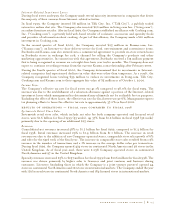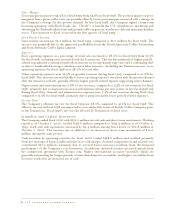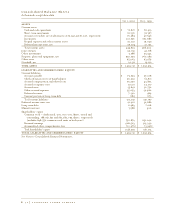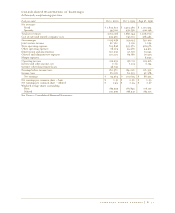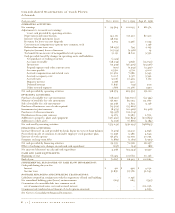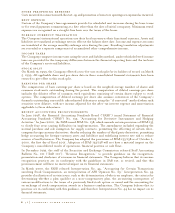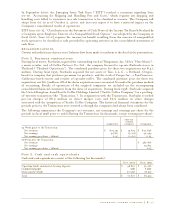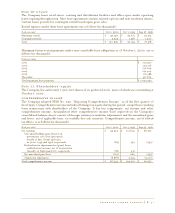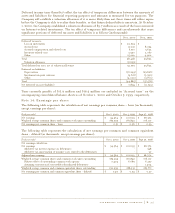Starbucks 2000 Annual Report Download - page 19
Download and view the complete annual report
Please find page 19 of the 2000 Starbucks annual report below. You can navigate through the pages in the report by either clicking on the pages listed below, or by using the keyword search tool below to find specific information within the annual report.
other investments
The Company has investments in privately held equity securities that are recorded at their estimated fair values.
fair value of financial instruments
The carrying value of cash and cash equivalents approximates fair value because of the short-term maturity
of those instruments. The fair value of the Company’s investments in marketable debt and equity securities
is based upon the quoted market price on the last business day of the fiscal year. The fair value and
amortized cost of the Company’s investments (short- and long-term) at October 1, 2000, were $61.3
million and $61.0 million, respectively. The fair value and amortized cost of the Company’s investments at
October 3, 1999, were $56.4 million and $56.2 million, respectively.
For equity securities of companies that are privately held, or where an observable quoted market price
does not exist, the Company estimates fair value using a variety of valuation methodologies. Such
methodologies include comparing the security with securities of publicly traded companies in similar lines
of business, applying revenue multiples to estimated future operating results for the private
company and estimating discounted cash flows for that company. For further information on investments,
see Notes 4 and 7. The carrying value of long-term debt approximates fair value.
inventories
Inventories are stated at the lower of cost (primarily moving average cost) or market.
property, plant and equipment
Property, plant and equipment are carried at cost less accumulated depreciation and amortization.
Depreciation of property, plant and equipment, which includes amortization of assets under capital
leases, is provided on the straight-line method over estimated useful lives, generally ranging from two to
seven years for equipment and 30 to 40 years for buildings. Leasehold improvements are amortized over
the shorter of their estimated useful lives or the related lease life, generally ten years. The portion of
depreciation expense related to production and distribution facilities is included in “Cost of sales and
related occupancy costs” on the accompanying consolidated statements of earnings.
goodwill
Goodwill resulting from business acquisitions represents the excess purchase price paid over net assets of
businesses acquired and is amortized on a straight-line basis over the period of expected benefit, which
ranges from ten to twenty years.
long-lived assets
When facts and circumstances indicate that the carrying values of long-lived assets, including intangibles,
may be impaired, an evaluation of recoverability is performed by comparing the carrying value of the assets
to projected future cash flows in addition to other quantitative and qualitative analyses. Upon indication
that the carrying value of such assets may not be recoverable, the Company recognizes an impairment loss
by a charge against current operations.
revenue recognition
Retail store revenues are recognized when payment is tendered at the point of sale. Specialty revenues,
consisting mainly of product sales, are generally recognized upon shipment to customers. Initial
non-refundable fees required under licensing agreements are earned upon substantial performance of
services. Royalty revenues based upon a percentage of sales and other continuing fees are recognized
when earned. All revenues are recognized net of any discounts.
advertising
The Company expenses costs of advertising the first time the advertising campaign takes place, except for
direct-to-consumer advertising, which is capitalized and amortized over its expected period of future
benefit, generally six to twelve months. Net capitalized direct-to-consumer advertising costs were $0.2
million and $2.5 million as of October 1, 2000 and October 3, 1999, respectively, and are included in
“Prepaid expenses and other current assets” on the accompanying consolidated balance sheets. Total
advertising expenses, recorded in “Store operating expenses” and “Other operating expenses” on
the accompanying consolidated statements of earnings, were $32.6 million, $38.4 million and $31.4
million in 2000, 1999, and 1998, respectively.
starbucks coffee company P. 35


